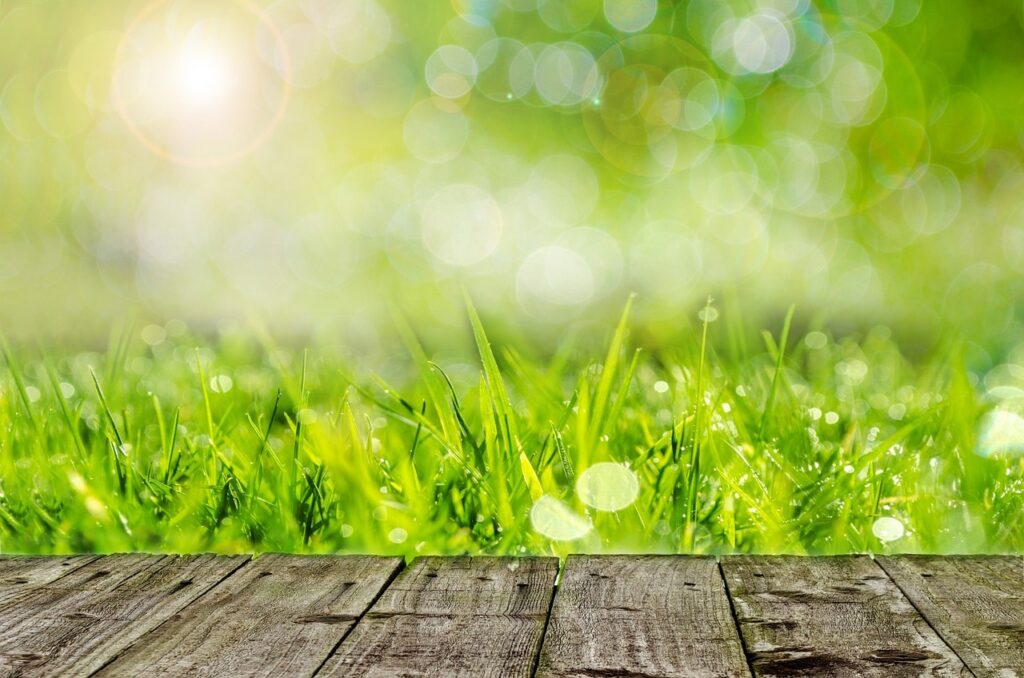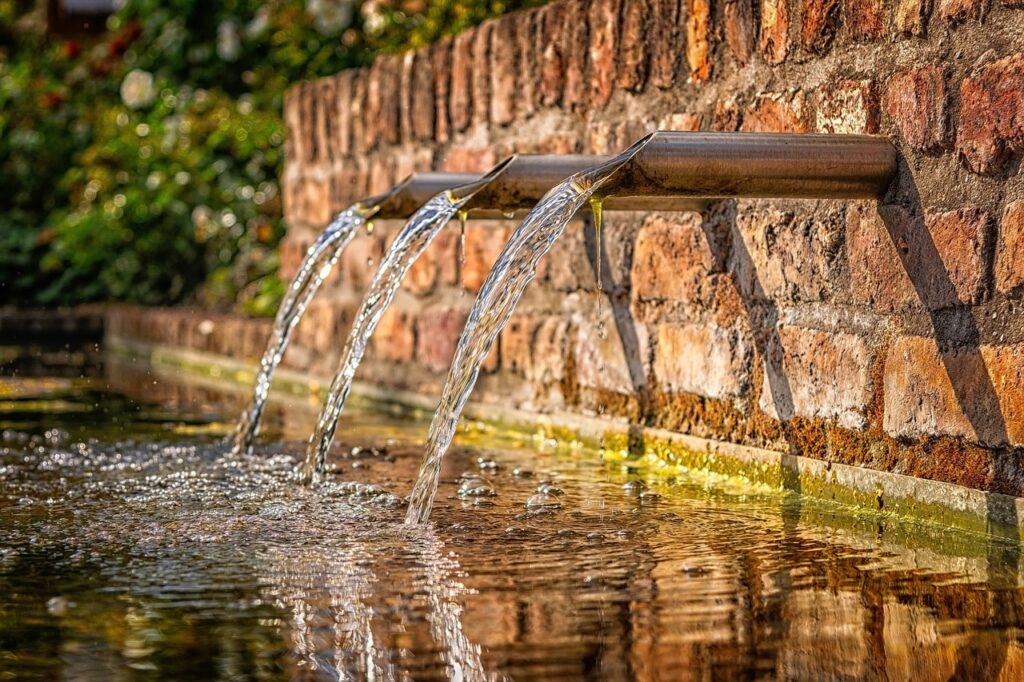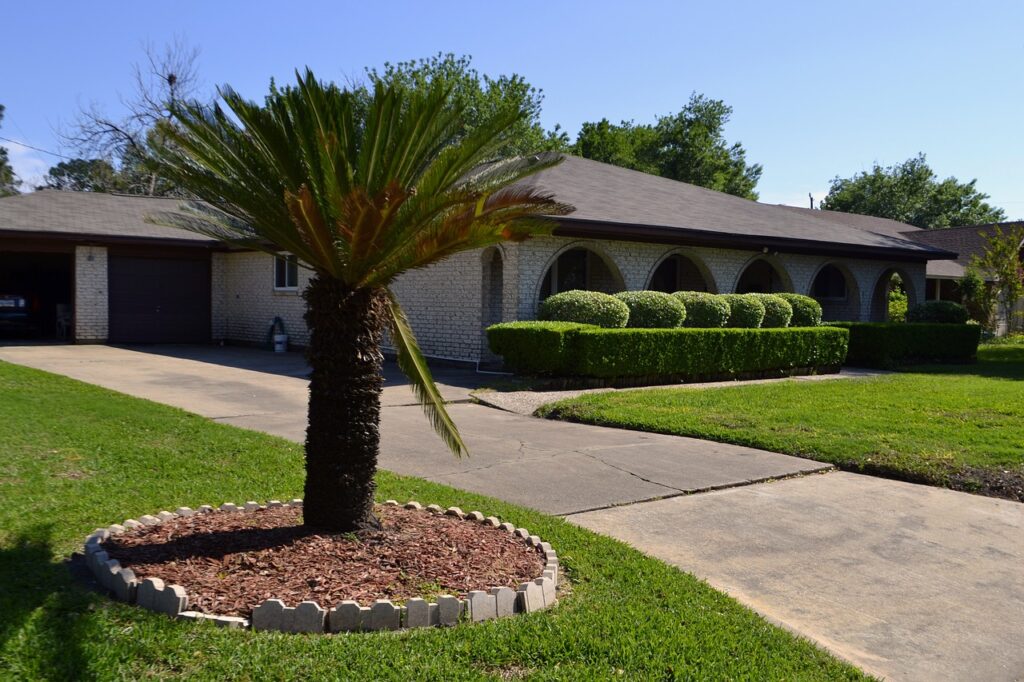
Mastering lawn care and landscaping provides an immense sense of pride and achievement for homeowners and gardeners. Aesthetically, you will create a welcoming curb appeal for visitors and an enjoyable outdoor atmosphere for family and friends. Like everything in life, achieving this beauty will require effort and dedication. In this blog, we will outline the best practices for lawn care and landscaping that will help you achieve a lush, green lawn and stunning outdoor property.
As an Amazon and ebay Affiliate we may earn a commission off any purchases made through our links. This won’t affect the price you pay.
Lawn Care
A beautiful lawn starts with proper lawn care. This includes regular watering, fertilization, mowing, and weed control. Let’s explore each of these vital elements of lawn care, in more detail.
Watering
Watering your lawn is crucial for its overall health and appearance. Correct watering will ensure that lawn care and landscaping are off to a good start. A properly watered lawn will lead to deeper root growth, fewer weeds, and a beautiful green color. It’s worth remembering that overwatering can be just as harmful as underwatering. On average, a lawn requires approximately one inch of water per week, including rainfall. To determine if your lawn is receiving enough water, you can use a simple test. Place a container, such as a coffee mug, on your lawn while watering and stop once the container is filled. This will help you have an accurate idea of how long you need to water your lawn. If you live in a hot, dry climate, you may need to water more often to maintain a hydrated lawn. If you notice that your grass blades are turning brown or gray, it’s time to give your lawn a good watering.

Fertilization
Another crucial aspect of lawn care and landscaping, is fertilization. Fertilizing your lawn will help keep it healthy and green, and promote root growth. The frequency and amount of fertilizer required will depend on the type of grass you have and your climate. A general rule of thumb is to fertilize your lawn once every six to eight weeks during the growing season. However, too much fertilizer can lead to an overly lush appearance, which can attract pests and diseases. Be sure to use the recommended amount of fertilizer for your specific lawn and climate needs.
Here is a general and basic month-by-month lawn care program. This is likely to vary in some areas or zip codes:
January
January is a dormant period for many lawns, particularly in colder regions. During this time, you should avoid walking on the lawn if there is frost. If you live in a milder climate or warm-season grass area, you may need to mow the turf if the growth rate is high.
February
February is the perfect time to sharpen your lawn mower blades. Dull blades can tear the grass blades instead of cutting them cleanly, leaving the turf susceptible to disease and pests. Additionally, you can start planning for the upcoming spring season by purchasing the necessary lawn care tools and supplies.
March
March marks the start of the spring season and the beginning of lawn care’s busiest time. The first thing to do is to clear out debris such as leaves and branches that may have accumulated on the lawn during the winter months. This will allow the grass to absorb sunlight and air. If your lawn has bare spots, you can overseed and fertilize to promote new growth.
—-
April
In April, you can begin to mow your lawn regularly. Make sure to adjust the mower’s height to the appropriate setting for your lawn type. Most lawns require a height of about 2 to 3 inches. You can also apply a pre-emergent herbicide to prevent crabgrass and other weeds from germinating.
May
May is the perfect month to fertilize your lawn with a slow-release fertilizer. Slow-release fertilizers will nourish your lawn gradually while ensuring that the nutrients are not lost to the environment.

June
In June, the summer season begins, which means higher temperatures and more frequent watering. You should aim to water your lawn at least once a week, applying approximately one inch of water. Also, use organic mulch like grass clippings, leaves, or wood chips to retain moisture in the soil.
July
In July, be sure to regularly check for pests such as grubs, ants, and chinch bugs. If you notice signs of damage, apply a targeted insecticide to protect your lawn. Additionally, if you live in a hot and dry area, you may need to water your lawn twice a week, increasing the amount of water applied per irrigation.
August
In August, weeds like crabgrass and dandelions can become a problem. Consider applying a post-emergent herbicide to kill any weeds that have popped up. Also, monitor your lawn’s water needs as the summer heat can impact hydration.
September
In September, you can apply an additional round of fertilizer to keep your lawn healthy and green. This will allow the grass to store essential nutrients as it prepares for the winter season. Additionally, you can aerate the lawn to improve airflow and allow nutrients and water to penetrate to the roots.
October

In October, as temperatures cool and rain increases, you can overseed with cool-season grass seed to promote a lush, green lawn in the upcoming winter months. This is also a good time to prepare your lawn for winter by raking leaves and debris and mowing the turf to a shorter height.
November
In November, apply a herbicide to prevent broadleaf weeds from appearing in your lawn during the winter months. You can also continue to mow the lawn regularly in areas with higher temperature averages.
December
In December, most lawns will be in a dormant state. It’s essential to avoid walking on the lawn if there is frost, as this can damage the dormant grass. Ensure no debris is left on the lawn that could damage the grass’s blade and cause an environment for pests to live in.
Mowing
Mowing is an essential part of maintaining a healthy lawn. However, improper mowing can be detrimental to a lawn’s health. To achieve a beautiful lawn, always mow when the turf is dry to avoid tearing the grass blades. Additionally, avoid cutting more than one-third of the grass blade length at once. Mowing too short can lead to damaged grass roots and an increased risk of pests and diseases. A good rule of thumb is to mow your lawn when it reaches approximately three inches in height. You can employ the services of a lawn mowing or care company to assist. There are many mower options from lightweight to robotic to commercial machines.

Weed Control
Weeds can overtake your lawn and ruin its overall appearance. To control weeds, there are several options such as hand pulling, herbicides, or a combination of both. Hand pulling is a viable option for small areas, but for larger infestations, it’s best to use herbicides. When choosing an herbicide, be sure to select one that is labeled for the type of weed you are trying to control. It’s also important to apply herbicides correctly, as misuse can lead to toxic buildup in the soil and negate the point of pest control.
Aeration
Lawn aeration is really important for complete lawn care. It will mean carefully, perforating your lawn’s soil to allow air, water, and nutrients to penetrate the grass roots. This will give the lawn a full service. Aeration can be done with specialized tools or by manually pushing a garden fork into the soil. Here is a step-by-step guide on how to aerate your lawn. This will give the lawn a full service. Aeration can be done with specialized tools or by manually pushing a garden fork into the soil. Here is a step-by-step guide on how to aerate your lawn.
1. Determine if Your Lawn Needs Aeration: You can perform the screwdriver test to see whether your lawn needs aeration. Push a screwdriver into the soil. If it’s challenging to push, then your lawn may require aeration.
2. Choose the Right Tool: There are two common tools used for lawn aeration, which are: a manual aerator (garden fork), that is great for small lawns and a mechanical aerator, which is more efficient and better for larger lawns.
3. Water Your Lawn: Water your lawn a day before aeration. Soil should always be moist before aeration.
4. Mow Your Lawn: The grass should be short before aeration. Mow your lawn to its usual height or lower.
5. Mark Obstacles: Mark any sprinkler heads, irrigation systems and other unseen obstacles so you avoid them during aeration.
6. Aerate Your Lawn: Start by making two passes over your lawn, making sure that the holes are at least 4-6 inches apart.
7. Clean Up: After aeration, it is common to have small plugs of soil on the lawn. These plugs will break down over time. However, you can rake them up and dispose of them if you desire.
8. Fertilize: Since aeration loosens the soil, it is an excellent time to fertilize your lawn. Fertilization allows for the nutrients to reach the roots more efficiently.
Landscaping
Assess Your Space
The first step in any landscaping project is to assess your space. Look at your yard and identify the existing features, such as plants, trees, and hardscapes. Make a note of any problem areas, such as slopes, drainage issues, or bare spots. This information will help you determine what can be enhanced and what needs improvement.
Create a Plan
Once you’ve assessed your space, it’s time to visualize, conceptualize, and create a plan. A landscaping plan includes the overall design of your outdoor space, the types of plants and materials you’ll use, and how they’ll work together. Consider the style you want to achieve, such as modern, traditional, or natural. Keep in mind your budget and the maintenance level of the plants and materials you select.

Select Your Plants and Materials
The selection of plants and materials is key to creating a successful landscape design. Consider the following:
Plants – Choose plants that are suited to your area and that are likely to thrive in your climate and soil conditions. Consider factors such as sun exposure, drainage, and water requirements. Place taller plants towards the back of your yard, medium plants in the center, and smaller plants in the front. Select a variety of colors and textures to add interest and depth to your design.
Hardscapes – Hardscapes are the human-made elements of your design, such as paths, walls, and patios. Consider the materials you want to use, such as brick, natural stone, or concrete. Think about the style you’re trying to achieve and how the hardscapes will work with the plants in your design.
Water Features – A water feature, such as a pond or fountain, can add a calming and relaxing element to your landscape design. Consider how much maintenance is required, as well as the sound and movement of the water.
Lighting – Lighting can add drama and interest to your outdoor space. Consider the types of lights you want to use, such as pathway lights, uplights, and downlights. Lighting can be used to highlight specific areas of your design, such as plants or hardscapes.
Create Focal Points
Focal points are the areas of your landscape design that draw the eye and create visual interest. A focal point can be a tree, arch, water feature, statue, or other any item that draws the eye. Consider how the focal point will work with the other elements in your design. A well-placed focal point can add depth and interest to your outdoor space.

Create Pathways
Pathways are an essential element of lawn care and landscaping. They guide visitors through your outdoor space and create a cohesive design. They can minimize traffic on lawns keeping the feet where you want them thus reducing wear and tear on your lawn and plant. Consider the style of your design when selecting the materials for your pathways. Pavers, brick, and natural stone can add a traditional feel, while concrete can create a modern look. Consider adding lighting, such as pathway lights or up-lights, to enhance the beauty of your pathways.
Add Mulch
Mulch is an essential element of landscaping that can provide numerous benefits. It has multiple benefits and helps retain moisture in the soil, regulates soil temperature, and suppresses weeds. Common types of mulch include bark chips, pine needles, and cocoa bean shells. Select the mulch that works best with the materials you have already used in the garden.
Maintain Your Design
Once you’ve created your landscaping design, it’s essential to maintain it. Regular maintenance ensures that your plants and materials remain healthy and beautiful. Maintenance includes watering, fertilizing, pruning, and cleaning. Schedule regular checkups to ensure that your outdoor space continues to thrive. Lawn care and landscaping are ongoing projects.
 water feature flowing into a pond
” class=”wp-image-4658″ style=”width:192px;height:auto”/>
water feature flowing into a pond
” class=”wp-image-4658″ style=”width:192px;height:auto”/>Achieving a lush, green lawn and beautiful landscaping takes time and effort. Regular lawn care practices such as watering, fertilization, mowing, and weed control help keep a healthy yard. Planting the right trees, shrubs, flowers, and hardscaping features add the finishing touch to create an outdoor oasis. With proper care and dedication, your outdoor space will become a standout in your neighborhood. Lawn care and landscaping really do go hand in hand.
As an Amazon and ebay Affiliate we may earn a commission off any purchases made through our links. This won’t affect the price you pay.
